Research Results
Toward the Production of Eco-Friendly Bioplastics
Exploring the Metabolic Mechanisms of Cyanobacteria that Produce Plastic Raw MaterialsFY2023
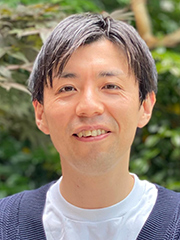
- OSANAI Takashi (Associate Professor, School of Agriculture, Meiji University)
- Advanced Low Carbon Technology Research and Development Program (ALCA)
- Practical Application Project, "Technology Development of High Efficient Bio Production by Innovative Cell Control Method and Breeding Method / Metabolic Engineering of Cyanobacteria for Fermentative Production of Succinate and Lactate ", Principal Investigator (2013-2022)
Highest record set for dicarboxylic acid production using cyanobacteria
This research team previously discovered that by fermenting a type of cyanobacteria (Synechocystis*1), glycogen in the cells is converted into compounds such as succinic acid and lactic acid, which are raw materials for bioplastics*2. As a result of continued research, they succeeded in improving the production of bioplastic compounds from cyanobacteria by "genetic modification" and "devising a fermentation method". It was found that by generating and fermenting a strain (CitHox) with a modified gene of malate dehydrogenase (MDH), an enzyme that catalyzes the reaction in the primary step of producing succinic acid from glycogen in cyanobacteria, the amount of dicarboxylic acids*3 including succinic acid released outside the cells increased. It was also clarified that the factors that inhibit the production of succinic acid are "succinic acid itself" and "acidification of the culture medium". A method was then developed to avoid suppression of production, and the highest production record of dicarboxylic acid using cyanobacteria was achieved.
In the course of further research, they "elucidated the relationship between sigma factors and promoters that regulate transcription in cyanobacteria", opening up the possibility of large-scale modification and control of gene expression in cyanobacteria, which could lead to increased production of bioplastics. They also worked on research leading to the production of useful materials using the citric acid cycle*4, the primary metabolism by which cells produce energy, and discovered a special citric acid cycle in which malic acid is converted to pyruvic acid instead of oxaloacetic acid.
*1 Synechocystis
Synechocystis is a type of cyanobacterium (a prokaryote that performs oxygen-producing photosynthesis), and the first cyanobacterium whose entire genome was sequenced in 1996. It has the advantages of rapid propagation, easy genetic modification, and cryopreservation. It has been widely used as a model cyanobacterium in both basic and applied research on cyanobacteria.
*2 Bioplastics
A generic term for biomass plastics made from renewable organic resources such as plants, and biodegradable plastics (which break down to carbon dioxide and water by the action of microorganisms).
*3 Dicarboxylic acids
Compounds with two carboxyl groups (-COOH), such as succinic acid, malic acid, and fumaric acid, are called dicarboxylic acids. Dicarboxylic acids are often useful raw materials for industrial chemicals, including bioplastics.
*4 Citric Acid Cycle (Tricarboxylic acid cycle, TCA cycle)
A pathway for organisms to generate reducing capability in the process whereby citric acid is converted into various substances, one after another. The reducing capability generated in the TCA cycle can be used to produce ATP through respiration. It is also the cycle that supplies substrates for synthesizing aminoacids and other substances.
Social demand for plastics with low environmental impact
Although plastics are conveniently used in a wide range of industrial products, they are also causing various environmental problems, such as marine plastic pollution. There are also concerns about the depletion of petroleum, the raw material used to make plastics, and reducing the amount of plastic used has become a social issue. In recent years, bioplastics that use renewable resources such as plants as raw materials instead of fossil fuels have been the focus of active research.
Cyanobacteria including Synechocystis are photosynthetic bacteria that store CO2 in the air as glycogen and synthesize various compounds including succinic acid and lactic acid, which are raw materials for bioplastics, through metabolic reactions (fermentation). However, the technology to control cyanobacterial cells and the nature of enzymes used in metabolic reactions (fermentation) to produce the desired materials have not yet been elucidated.
Elucidating the mechanism of carbon metabolism in cyanobacteria
The research team, aiming to increase the production of bioplastic compounds using cyanobacteria (Synechocystis), focused on malate dehydrogenase (MDH, gene citH). They then generated a CitHox strain in which the gene was modified (strongly expressing the malate dehydrogenase gene citH) in the Synechocystis cells. Next, the wild-type strain (without genetic modification) and the CitHox strain were cultivated and fermentation was carried out with a lower cell volume to examine the effect of genetic modification, revealing that the levels of dicarboxylic acids (succinic acid, fumaric acid and malic acid) were higher in the CitHox strain than in the wild-type strain (Fig. 1).
In addition, aiming to increase the production of dicarboxylic acids, they fermented the cyanobacteria under high-density conditions with an increased cell volume used for fermentation. When fermentation was performed with a 10-fold increase in cell volume, the amount of dicarboxylic acid produced increased, but not by a factor of 10. This suggested that the production of dicarboxylic acid was inhibited by some factor at higher densities.
The team considered two possibilities as inhibitors of dicarboxylic acid production and confirmed that (1) the substance produced (dicarboxylic acid) itself interferes with the reaction in progress, and (2) the ionization state of carbon compounds in solution changes due to the acidification of the medium, resulting in lower dicarboxylic acid production. Therefore, in order to remove the inhibiting factors in production, they developed a "stripping method" (Fig. 2) to renew the medium during fermentation and conducted experiments, achieving the highest dicarboxylic acid production from cyanobacteria known to date (total succinic acid, fumaric acid, and malic acid produced in 4 days were 4.2 g/L, 2.7 g/L, and 4.6 g/L, respectively).
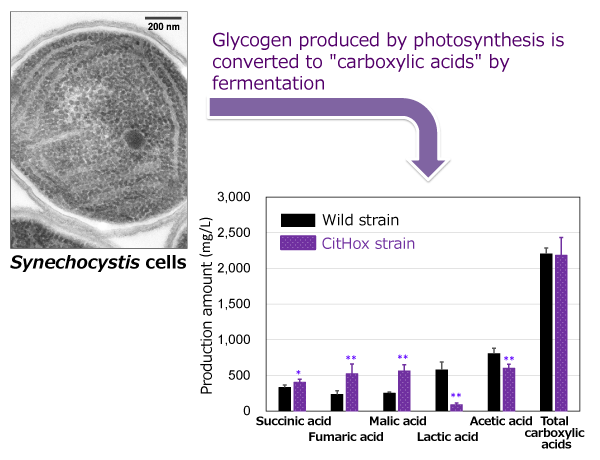
Fig. 1 Conversion of glycogen to carboxylic acids in Synechocystis.
Synechocystis can store glycogen through photosynthesis. The left figure shows a Synechocystis cell with a glycogen accumulation of about 50%. This stored glycogen is converted into carboxylic acids by fermentation. Amount of carboxylic acids released outside the cell is shown in black for wild strain and in purple for CitHox strain. The figure shows the mean and standard deviation values of the data from six experiments (*P<0.05, **P<0.005)
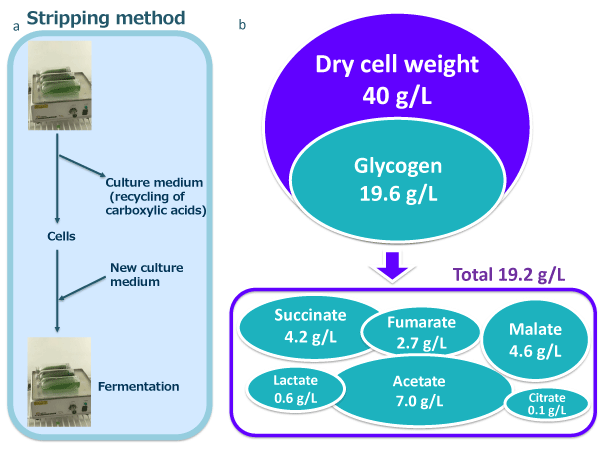
Fig. 2 Carboxylic acid production using the stripping method
The team also conducted research on genetic modification of cyanobacteria (Synechocystis) that plays an important role in the process of producing organic acids, a compounds for bioplastics, by using the pathway for glycogen degradation. In Synechocystis, an alternative sigma factor*5 SigE functions to express an enzyme that degrades sugar. The research team conducted chromatin immunoprecipitation sequencing (ChIP-seq) (Fig. 3) experiments to determine where SigE binds on the genome of Synechocystis. As a result, they were able to identify the genomic binding sites of SigE, the alternative sigma factor involved in cyanobacterial glycolysis and bioplastic production.
*5 Sigma factors
When the environment changes, organisms respond by changing the genes they transcribe. In prokaryotes, proteins called sigma factors select genes to be transcribed. By using multiple types of sigma factors, genes that respond to environmental changes can be activated. Sigma factors select genes to be transcribed by binding to DNA sequences in the promoter region of the genes. A group of genes essential for survival (housekeeping genes) are transcribed by sigma factors called major sigma factors, while a group of genes that respond to environmental changes are transcribed by sigma factors called alternative sigma factors.
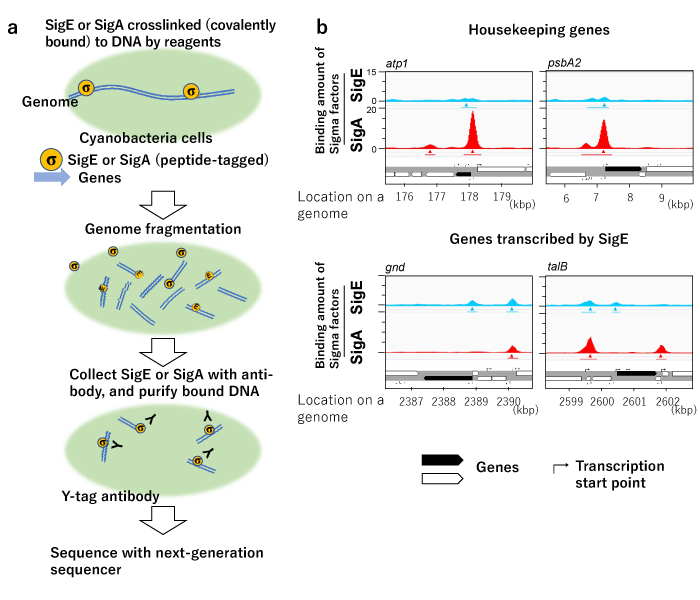
Fig. 3
(a) Schematic diagram of the ChIP-seq method.
(b) Binding sites of SigE and SigA found by ChIP-seq method. The horizontal axis is the position on the Synechocystis genome, and the vertical axis is the binding strength of SigE or SigA to the genomic region.
The research team also attempted to elucidate the TCA cycle of a unicellular cyanobacterium Synechocystis. The TCA cycle, an important metabolic pathway for both biological activity and substance production, produces an energetic substance called NADH*6 in the process of oxidizing metabolites through an enzymatic reaction. Usually, malic acid is converted to oxaloacetic acid in the TCA cycle by the action of malate dehydrogenase (MDH). In cyanobacteria, however, malate dehydrogenase activity is low, and it was unclear how malate is converted. Cyanobacteria also have another malate-converting enzyme, malic enzyme (ME), which converts malate to pyruvate, but it was not known how this enzyme works in the TCA cycle instead of malate dehydrogenase. The team's analysis revealed that ME, not MDH, converts malate in the TCA cycle of cyanobacteria, and that malate is converted to pyruvate, not oxaloacetate (Fig. 4).
*6 NADH
Nicotinamide adenine dinucleotide. It acts as a reducing agent that donates electrons in enzymatic redox reactions in both eukaryotic and prokaryotic organisms.
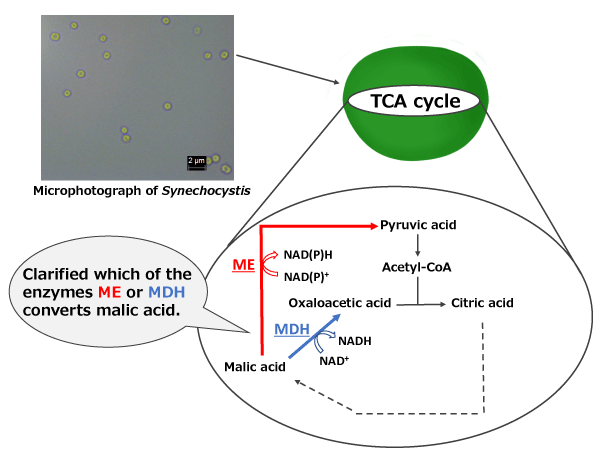
Fig. 4 Conversion of malic acid by ME and MDH
Toward the practical application of bioplastic production
The research team succeeded in producing dicarboxylic acids at the world's highest level by 'genetic modification' of cyanobacteria and ‘improvement of fermentation methods.’ Further research is expected to lead to the practical application of carbon dioxide-based bioplastic raw material production.
This approach to genetic modification will lead to the acquisition of knowledge on the basis of material production by Synechocystis. In cyanobacteria, there are other strains that have various material production advantages besides Synechocystis, and it is expected that this knowledge will also be useful in the production of materials by genetic modification of these species. The results of the study of enzymatic reactions in the TCA cycle of Synechocystis will also lead to an understanding of enzymatic reactions involved in the TCA cycle of various organisms.
Associate Professor Osanai research activities on cyanobacteria led him to establish Cyanology Co., Ltd., a Meiji University venture that supports researchers aiming to use microalgae for decarbonization and other purposes. Since its establishment, the company has successfully marketed a number of products and services. It also signed contracts with companies listed on the Stock Exchange and Meiji University, and concluded an agreement on intellectual property rights with Meiji University in exchange for subscription rights. It is expected to become a new success example of a university-based venture.
- Life Science
- Research Results
- Japanese
